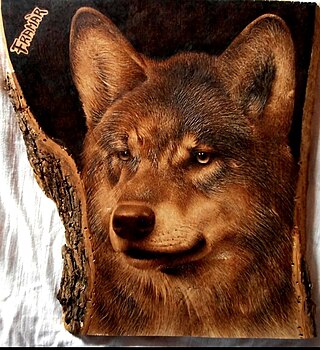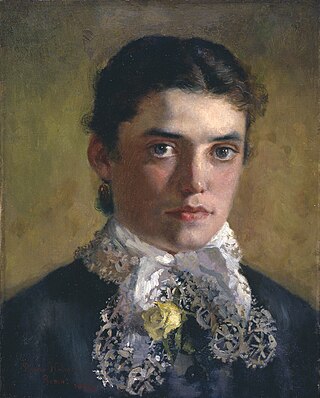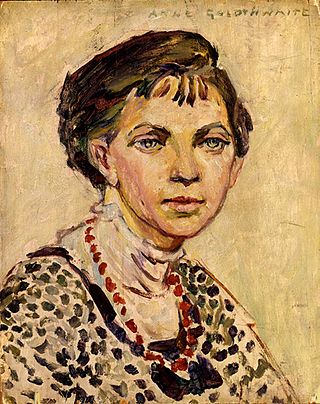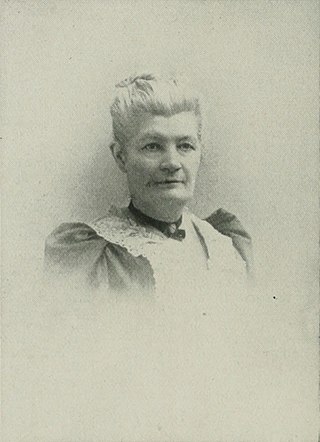
Pyrography or pyrogravure is the free handed art of decorating wood or other materials with burn marks resulting from the controlled application of a heated object such as a poker. It is also known as pokerwork or wood burning.

Samuel Colman was an American painter, interior designer, and writer, probably best remembered for his paintings of the Hudson River.

Frank Weston Benson, frequently referred to as Frank W. Benson, was an American artist from Salem, Massachusetts known for his Realistic portraits, American Impressionist paintings, watercolors and etchings. He began his career painting portraits of distinguished families and murals for the Library of Congress. Some of his best known paintings depict his daughters outdoors at Benson's summer home, Wooster Farm, on the island of North Haven, Maine. He also produced numerous oil, wash and watercolor paintings and etchings of wildfowl and landscapes.

Rhoda Holmes Nicholls was an English-American watercolor and oil painter, born in Coventry, England. She studied art in England and Italy, and her work was viewed and praised at the time by the queens of both countries. A body of work was created in South Africa by Nicholls of Port Elizabeth area's scenery, wildlife and architecture. She lived there on her brothers' 25,000-acre ostrich farm for one year.

Anne Goldthwaite was an American painter and printmaker and an advocate of women's rights and equal rights. Goldthwaite studied art in New York City. She then moved to Paris where she studied modern art, including Fauvism and Cubism, and became a member of a circle that included Gertrude Stein, Henri Matisse, and Pablo Picasso. She was a member of a group of artists that called themselves Académie Moderne and held annual exhibitions.

Jennie Augusta Brownscombe was an American painter, designer, etcher, commercial artist, and illustrator. Brownscombe studied art for years in the United States and in Paris. She was a founding member, student and teacher at the Art Students League of New York. She made genre paintings, including revolutionary and colonial American history, most notably The First Thanksgiving held at Pilgrim Hall in Plymouth, Massachusetts. She sold the reproduction rights to more than 100 paintings, and images of her work have appeared on prints, calendars and greeting cards. Her works are in many public collections and museums. In 1899 she was described by New York World as "one of America's best artists."

Florence Esté was an American painter in oils born in Cincinnati, Ohio. She also worked in watercolors, pastels, and as an etcher and engraver. She was particularly well known for her landscapes, which were said to have been influenced by Japanese artworks and were noted for their "harmony of color". Her obituary in the New York Times referred to her as "one of the best known women landscape painters."

Margaret Ely Webb (1887–1965) was an American illustrator, printmaker, and bookplate artist. She was part of the Arts and Crafts movement of the early 1900s.

Agnes Weinrich was an American visual artist. In the early twentieth century, she played a critical role in introducing cubist theory to American artists, collectors, and the general public and became one of the first American abstractionists. A life-long proponent of modernist art, she was an active participant in the art communities of Provincetown and New York. Early in her career, she traveled widely in Europe and spent extended periods studying in Paris and Berlin. She also studied art in Chicago, Provincetown, and New York. During most of her career, she worked in a Provincetown studio during the warm months and a Manhattan studio during the cold ones. Weinrich's easel work included oil paintings, watercolors, and pastels. She also made block prints and etchings and drew using pencil and crayon. Her paintings, prints, and drawings appeared in solo and group exhibitions throughout her career and she received favorable critical attention both during her life and after her death.

Mabel Dwight (1875–1955) was an American artist whose lithographs showed scenes of ordinary life with humor and tolerance. Carl Zigrosser, who had studied it carefully, wrote that "Her work is imbued with pity and compassion, a sense of irony, and the understanding that comes of deep experience." Between the late 1920s and the early 1940s, she achieved both popularity and critical success. In 1936, Prints magazine named her one of the best living printmakers and a critic at the time said she was one of the foremost lithographers in the United States.
The Woman's Art Club of New York was founded in New York City in 1889 and provided a means for social interaction and marketing of women's works of art. The club accepted members from the United States and abroad. In 1913, the group changed its name to the National Association of Women Painters and Sculptors. The current name for the group is the National Association of Women Artists, which was adopted in 1941.

Sears Gallagher was an American artist proficient in drawing, etching, watercolor and oil painting. His work consisted largely of landscapes, seascapes, and cityscapes depicting his native Boston and northern New England, especially Monhegan Island, Maine. Illustrating magazines and books provided steady work and income, and his etchings and prints attracted popular demand. Gallagher took his art seriously, adapted new techniques, and was open to the influence of European Impressionism. During the height of his career his watercolors were favorably compared to those of Winslow Homer and F. W. Benson, and his etchings and drypoints to those of James McNeill Whistler.
Alice Edith Rumph (1878–1978) was a painter of watercolors and pastels, an etcher, and an art teacher. Rumph co-founded the Birmingham Art Club, which established the Birmingham Museum of Art in Birmingham, Alabama. She served as the club's founding vice president and later as its president. In 2004, Birmingham Historical Society published Art of the New South: Women Artists of Birmingham 1890-1950. The volume features the artwork of Rumph and seven other prominent artists from the city.
Adelaide Deming was an American painter, associated for much of her life with Litchfield, Connecticut. She was the 1908 winner of the Beal Prize for her watercolor Moon Shadows.
The Black and White Club was an art association in New York. It held monthly exhibits by 1895.

Emily Maria Scott was an American artist. The New York Watercolor Club, and the Pen and Brush Club were formed in her studio. She was also a writer of magazine articles. She served as president of the National Association of Women Painters and Sculptors, vice president New York Water Color Club, and was a member of the Pen and Brush Club, the American Water Color Society, the New York Women's Art Club, and the National Arts Club."

Anne Steele Marsh (1901–1995) was an American painter and printmaker whose watercolors, oil paintings, and wood engravings were widely exhibited and drew critical praise. She was also a noted educator and arts administrator.

Sybilla Mittell Weber (1892–1957) was an American artist known for her etchings and drypoints of dogs and horses. She was trained by an Austrian animal painter at the Academy of Fine Arts Munich and by an American etcher at the Art Students League. With the skills they taught her, she embarked on a long and successful career during which she employed traditional techniques to achieve results that drew consistent critical praise. Admired for her skill in animal portraiture and for her ability to portray animals in action, she was said to use an "economy of line" to achieve a style situated between the extremes of pure realism and pure abstraction.
Earl Horter was an American painter, illustrator, printmaker, teacher and art collector. He was instrumental in introducing modern art to Philadelphia as both an artist and collector of Cubist and abstract art. During the 1920s, he had one of the largest collections of modern art in the United States, and he was among the most prominent etchers of his generation.

Dorothy Lake Gregory (1893–1975) was an American artist best known for her work as a printmaker and illustrator of children's books. She took art classes in public school and at the age of fourteen began making drawings for a New York newspaper. She studied art in Paris in her late teens and thereafter took classes at Pratt Institute, the Art Students League of New York, and the Cape Cod School of Art. Her career as a professional artist began with her participation in an exhibition of paintings at the Art Students League in 1918. Her first book illustrations appeared three years later. She first showed prints in an exhibition held in 1935. She continued as artist, illustrator, and printmaker for most of the rest of her life employing throughout a different style for each of the three media. In 1956, a critic contrasted the "cubistic" painting style of that time with the book illustration style for which she was better known, saying he had heard gallery-goers incredulously remark, "But she can't be the same Dorothy Lake Gregory."

















